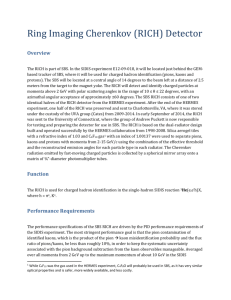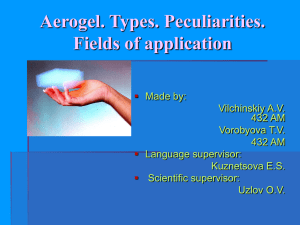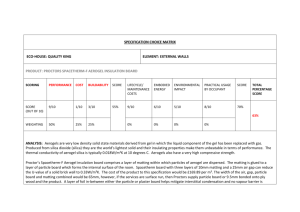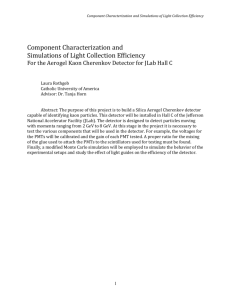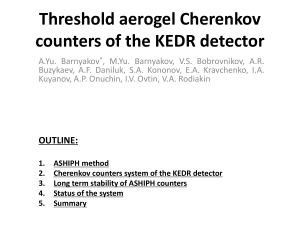Nathaniel`s Report - The Catholic University of America
advertisement
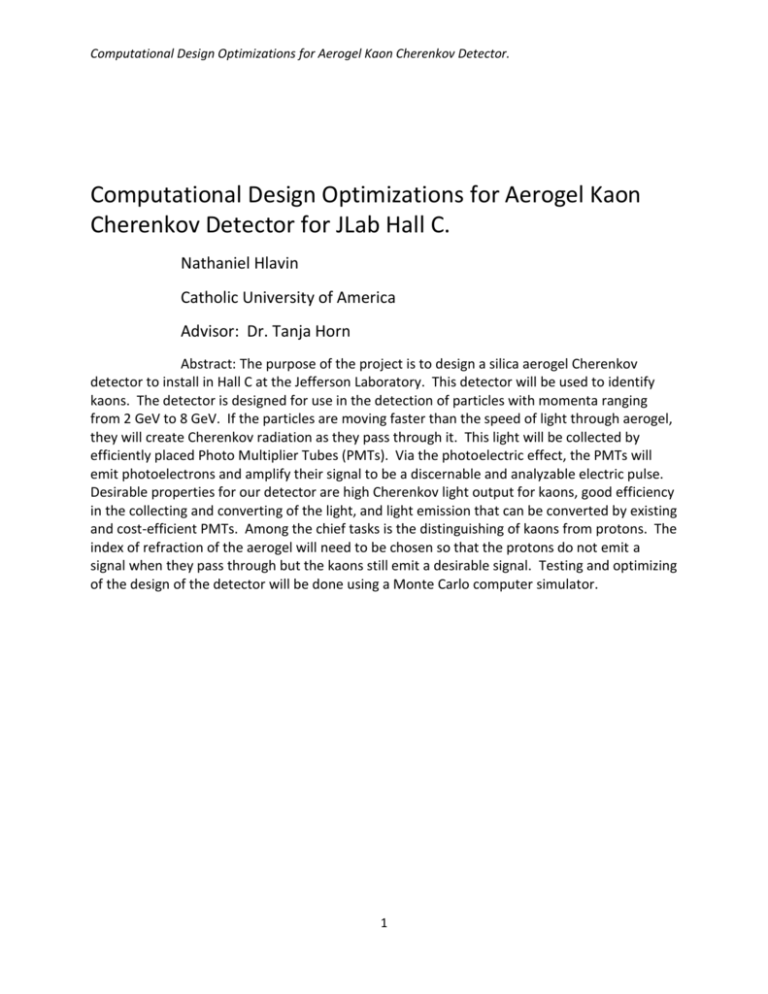
Computational Design Optimizations for Aerogel Kaon Cherenkov Detector. Computational Design Optimizations for Aerogel Kaon Cherenkov Detector for JLab Hall C. Nathaniel Hlavin Catholic University of America Advisor: Dr. Tanja Horn Abstract: The purpose of the project is to design a silica aerogel Cherenkov detector to install in Hall C at the Jefferson Laboratory. This detector will be used to identify kaons. The detector is designed for use in the detection of particles with momenta ranging from 2 GeV to 8 GeV. If the particles are moving faster than the speed of light through aerogel, they will create Cherenkov radiation as they pass through it. This light will be collected by efficiently placed Photo Multiplier Tubes (PMTs). Via the photoelectric effect, the PMTs will emit photoelectrons and amplify their signal to be a discernable and analyzable electric pulse. Desirable properties for our detector are high Cherenkov light output for kaons, good efficiency in the collecting and converting of the light, and light emission that can be converted by existing and cost-efficient PMTs. Among the chief tasks is the distinguishing of kaons from protons. The index of refraction of the aerogel will need to be chosen so that the protons do not emit a signal when they pass through but the kaons still emit a desirable signal. Testing and optimizing of the design of the detector will be done using a Monte Carlo computer simulator. 1 Computational Design Optimizations for Aerogel Kaon Cherenkov Detector. 1. Introduction Generalized Parton Distributions (GPD) are used to understand the internal structure of nucleons. By observing and analyzing data taken from particles produced in hard scattering meson electroproduction (diagram below), we can construct the GPD of the proton.1 Pictured below are some examples of GPDs generated by models. We are looking for experimental data to generate actual GPDs for the proton. The x variable is the fraction of the momentum of the quark over the momentum of the proton. Different x values result in different distributions. Generalized Parton Distributions Meson Electroproduction 2 Computational Design Optimizations for Aerogel Kaon Cherenkov Detector. However, for the data to have this desired effect, it must conform to the hard, or perturbative, quantum chromodynamic (QCD) form factorization. Meson Form Factors T . Unfortunately, as can be seen in the plot2 pictured above, current form factors for the pion do not match up with the QCD model. Some data on the kaon has been produced, but further experiments could determine if the kaon’s form factors match up with hard QCD and could be used to construct the GPD. To that end, a new detector is being developed to detect kaons in the Super High Momentum Spectrometer (SHMS) in JLab Hall C.3 2. Theory The proposed detector would be an Aerogel Cherenkov detector. As charged particles, in our case kaons, pass through a material faster than the speed of light through that material, light is emitted in a process that is analogous to a sonic boom. This is called Cherenkov radiation and can be utilized to detect high energy sub-atomic particles. Aerogel, even though it is a delicate substance, has a very low index of refraction and so is ideal for good light output from these very small high energy particles.4 The light from this process goes into a lightbox where it is collected by Photomultiplier Tubes (PMT) and turned into electric signal via the photoelectric effect. This signal is then amplified so that it can be analyzed. 3 Computational Design Optimizations for Aerogel Kaon Cherenkov Detector. 2.1 Varied Indices The detector would be used to detect particles with momenta from 2-8 GeV/c. However, since no one refractive index of the aerogel produces a kaon signal only for this range, multiple refractive indices would be needed. A pion signal always occurs for all momentum values, but since this is already distinguished from the kaon signal by another detector, we do not have to take this into account. However, for many momentum values and indices, a proton signal is emitted and would introduce error into our kaon values. This proton signal needs to be minimized, while still maximizing the desired kaon signal. This presents one major challenge for detector design. 2.2 Other Design Constraints Other design constraints include geometric constraints due to the placement of our detector within the SHMS detector stack. We have been left approximately 45 cm of space for our entire detector. Also, being financially efficient with our materials is a high priority, which is why we are building an Aerogel Cherenkov detector rather than the pricier RICH detector. 2.3 Preliminary Calculations Before any experimental testing we chose several likely values of efficient refractive indices using an equation5 that gives the number of emitted photoelectrons for standard Cherenkov radiation and photoelectric collection. 𝛼2 𝑧 2 𝑁𝑝.𝑒. = L 𝑟 𝑚 𝑒 𝑒𝑐 2 ∫ 𝜖 𝑑(𝐸) sin2 𝜃𝑐 (𝐸)𝑑𝐸 (1) 𝛼2 where L is the thickness of the aerogel and z = 1 and 𝑟 𝑚 𝑒 𝑒𝑐 2 = 370 𝑐𝑚−1 𝑒𝑉 −1 . ∫ 𝜖 𝑑(𝐸) is the efficiency percentage, which is our case multiplies out to be 11.2%. This percentage includes the reflectivity of the aerogel, the absorption percentage of the PMTs, the quantum efficiency of the PMTs, and the reflectivity of the Millipore paper that lines the lightbox.6 To find some of these likely values, equation (1) is used to calculate the number of photoelectrons for a range of refractive indices (1.007-1.127) and momentum values (2-8 GeV). From these 7 plots (Graphs 1-7 in appendix) several candidates can be discerned. We chose 1.01, 1.015, 1.02, and 1.03. Graphs 8-11 show the plots of number of photoelectrons across the range of momentum for each of these refractive indices. From these graphs it is evident different indices are more ideal for different parts of the momentum range. 1.03 seems to be a good choice for 2-4 GeV and 1.015 seems to be a be a good choice for 4-6 GeV. No refractive index seems to be a good choice for the higher values of 6-8 GeV. For this part of the range we can use kinematic separation to distinguish protons and kaons. 4 Computational Design Optimizations for Aerogel Kaon Cherenkov Detector. 3. Experimental Simulation With these four refractive index values in hand we move on to experimental testing. In order to test the various parameters and characteristics of our detector to achieve the optimal design, we used a Monte Carlo computer simulation for Aerogel Cherenkov detectors called SimCherenkov, originally written by D.W. Higinbotham of Jefferson Lab.7 It is written in the programming language FORTRAN, so this language was adopted for any additional programming as well. In order to fully test all the characteristics of the detector, some supplementary features were added to the program. The program originally allowed for PMTs to be placed on the east and west walls of the lightbox. Additional choices were added to put PMTs on the north and south walls, as well as a three-walled and four-walled configuration option. To this end, we increased the total number of PMTs able to be used from sixteen to thirty-two. We also provided an option to have a mix of PMTs with different radii, with the larger PMTs in the center of the walls. This option was available for the three-walled setup only. The program itself already provided for the adjustment and testing of a number of other variables, such as the thickness of the aerogel, the depth of the lightbox, the refractive index of the aerogel, the size of the aerogel panel, and the efficiency percentages of the various components of the detector. The detector’s design was optimized using this program to test each design characteristic one at a time. For all the following optimization tests the refractive index was held at 1.015 3.1 Length and Width of Aerogel Panel The first design characteristic that was optimized was the length and width dimension of the aerogel panel. In this investigation the density distribution of incident particles must be considered. At our placement in the SHMS this distribution takes an hourglass shape (pictured below) due to the focusing and defocusing magnets that bend the particles into the SHMS. A 110x100 cm panel encloses the entire distribution, and a 90x60 cm panel encloses the area of greatest density. 5 Computational Design Optimizations for Aerogel Kaon Cherenkov Detector. 8.00 7.00 Number of Photoelectrons 90x60 cm Panel Size 110x80 cm 6.00 110x100 cm 5.00 4.00 3.00 2.00 1.00 0.00 0 2 4 6 Momentum (GeV) 8 10 The pictured plot shows the photoelectron output for 3 different sizes of panel. It is clear that the optimal size is the one that encloses the area of greatest density in the distribution, 90x60. The difference in size of these panels necessitates a different number of PMTs as well but all setups have as many 5” radius PMTs as will fit. 3.2 Thickness of Aerogel A further dimension of the aerogel that had to be optimized was the thickness. Here we must remember that this is the dimension that is constrained by 45 cm slot allotted for this detector in the SHMS. The aerogel thickness and the depth of the lightbox must not sum to a number higher than ~45. The thicknesses that were tried were 5 cm, 8 cm, and 10 cm. Below is the graph of the photoelectron outputs for these thicknesses. 16.00 Aerogel Thickness Number of Photoelectrons 14.00 10 cm 12.00 8 cm 10.00 5 cm 8.00 6.00 4.00 2.00 0.00 0 1 2 3 4 5 Momentum (GeV) 6 6 7 8 9 Computational Design Optimizations for Aerogel Kaon Cherenkov Detector. Clearly, the 10 cm thickness offers a significant boost in photoelectron output. It is a large enough increase to justify the extra financial cost of the increased amount of aerogel. 3.3 Photomultiplier Tube Placement A more complicated challenge is the optimization of the PMT configuration. Here, the dimensions of the box also play a role, so some of the optimization involved changing the previously optimized aerogel panel size. Perhaps if the PMT configuration was sufficiently optimized, the panel would actually be more efficient with a different size. As it turns out, the same panel size remained optimal, with 5” PMTs on three sides. Pictured below is the photoelectron output plot for the various configurations. Larger panel dimensions, even with the addition of more PMTs, did not produce higher signals. A one-sided configuration was very poor. The two-sided configuration, either N/S or E/W did not improve very much. Mixing PMTs of different radii on three sides was only a slight improvement on the two side setup. One four-sided setup was tried, but its results do not matter because the SHMS does not allow for four sides of PMTs. Three sided layouts were the best, and among them the optimized panel size emitted the highest signal. For this panel size 6 5” PMTs were put on the E/W sides and 4 5” PMTs on the smaller N side. 7 Computational Design Optimizations for Aerogel Kaon Cherenkov Detector. 3.4 Lightbox depth/PMT coverage percentage. A final design characteristic to investigate was the depth of the light box. This, like the aerogel thickness, is constrained by the ~45cm amount of space in the SHMS. Here, the values assessed were 22.5 cm, 24.5 cm, and 26.5 cm. The sum of any of these and the optimized aerogel thickness does not exceed this constraint. When the simulations had been run for these three depths, 22.5 was shown to be the optimal value. This is because it decreased the total surface area of the lightbox, which in turn increased the PMT coverage percentage. The higher the PMT coverage percentage, the more efficient photon collection is. The gain in signal was very small, however, with only a 4% gain when the curves are furthest apart. Graph below. 7.00 Lightbox Depth Number of Photoelectrons 6.50 6.00 5.50 5.00 4.50 4.00 3.50 3.00 4 5 6 Momentum (GeV) 7 8 4. Results The results gained from our computer simulation study are optimized design characteristics for the Kaon Aerogel Cherenkov Detector. Several refractive indices of aerogel must be used, with 1.03 for the lower momenta (2-4 GeV), 1.015 for the midrange momenta (4-6 GeV), and kinematic separation for the higher momenta (6-8 GeV). The aerogel panel itself ought to enclose the area of highest density of the hourglass distribution, 90x60 cm. The aerogel should be 10 cm thick to maximize photoelectron output. The PMTs should be configured according to the optimal panel size, fitting a 6x6x4 5” PMT layout. The lightbox could be adjusted to be shallower to increase PMT coverage slightly, but this was shown to not significantly change performance. 5. Conclusion Using the tools of computational physics and computer programming, we were able to find the optimum design for a Kaon Aerogel Cherenkov Detector. Further steps include creating technical drawings to aide in communication of this design to those who will construct the detector. Plans to test the components of the detector such as aerogel 8 Computational Design Optimizations for Aerogel Kaon Cherenkov Detector. and PMTs in a small scale experiment have also been made. Use of this detector could provide us with data to find out whether the resulting form factor for the kaon will match the current hard QCD model. Should this occur, the GPD of the proton would perhaps be within reach. Acknowledgements: The author would like to thank Dr. Tanja Horn for mentoring and advising this work and the research behind it, and the Catholic University of America Physics Department for providing the opportunity. References: 1 T. Horn et al., Proposal to JLab PAC 34, Studies of L-T separated Kaon Electroproduction at 5-11 GeV, December 15, 2008 2 T. Horn et al., Phys. Rev. Lett. 97 (2006) 192001.; T. Horn et al., arXiv:0707.1794 (2007). ; A.P. Bakulev et al, Phys. Rev. D70 (2004)] 3 T. Horn et al., E12-09-011, L/T separated Kaon cross sections at JLab 11 GeV Nuclear Instruments and Methods in Physics Research A 553 (2005) 364-369 5 Physics Review Letters, Volume 592, Issue 1-4 (2004) 6 R. Asaturyan et al., arXiv:physics/0411147v1 [physics.ins-det] 16 Nov 2004 7 Nuclear Instruments and Methods in Physics Research A 414 (1998) 332-339 4 Appendix: 1. (For Graphs 1-11, Blue = Kaon, Red = Proton) 80 Momentum = 2 GeV 70 Number of Photoelectrons 60 50 40 30 20 10 0 1.000 -10 1.020 1.040 1.060 1.080 1.100 Refractive Index 9 1.120 1.140 Computational Design Optimizations for Aerogel Kaon Cherenkov Detector. 2. 90 Momentum = 3 GeV 80 Number of Photoelectrons 70 60 50 40 30 20 10 0 1.000 -10 1.020 1.040 1.060 1.080 1.100 1.120 1.140 Refractive Indices 3. 90 Momentum = 4 GeV 80 Number of Photoelectrons 70 60 50 40 30 20 10 0 1.000 -10 1.020 1.040 1.060 1.080 1.100 Refractive Index 10 1.120 1.140 Computational Design Optimizations for Aerogel Kaon Cherenkov Detector. 4. 90 Momentum = 5 GeV 80 Number of Photoelectrons 70 60 50 40 30 20 10 0 1.000 -10 1.020 1.040 1.060 1.080 1.100 1.120 1.140 1.120 1.140 Refractive Index 5. 100 90 Momentum = 6 GeV Number of Photoelectrons 80 70 60 50 40 30 20 10 0 1.000 -10 1.020 1.040 1.060 1.080 1.100 Refractive Index 11 Computational Design Optimizations for Aerogel Kaon Cherenkov Detector. 6. 100 Momentum = 7 GeV 90 Number of Photoelectrons 80 70 60 50 40 30 20 10 0 1.000 1.020 1.040 1.060 1.080 1.100 1.120 1.140 Refractive Index 7. 100 90 Momentum = 8 GeV Number of Photoelectrons 80 70 60 50 40 30 20 10 0 1.000 1.020 1.040 1.060 1.080 1.100 Refractive Index 12 1.120 1.140 Computational Design Optimizations for Aerogel Kaon Cherenkov Detector. 8. 7 n = 1.01 Number of Photoelectrons 6 5 4 3 2 1 0 0.00 2.00 -1 4.00 6.00 8.00 10.00 8.00 10.00 Momentum (GeV) 9. 12 n = 1.015 Number of Photoelectrons 10 8 6 4 2 0 0.00 -2 2.00 4.00 6.00 Momentum (GeV) 13 Computational Design Optimizations for Aerogel Kaon Cherenkov Detector. 10. 16 n = 1.02 Number of Photoelectrons 14 12 10 8 6 4 2 0 -2 0.00 2.00 4.00 6.00 Momentum (GeV) 8.00 10.00 11. Number of Photoelectrons 25 n = 1.03 20 15 10 5 0 0.00 -5 2.00 4.00 6.00 Momentum (GeV) 14 8.00 10.00
